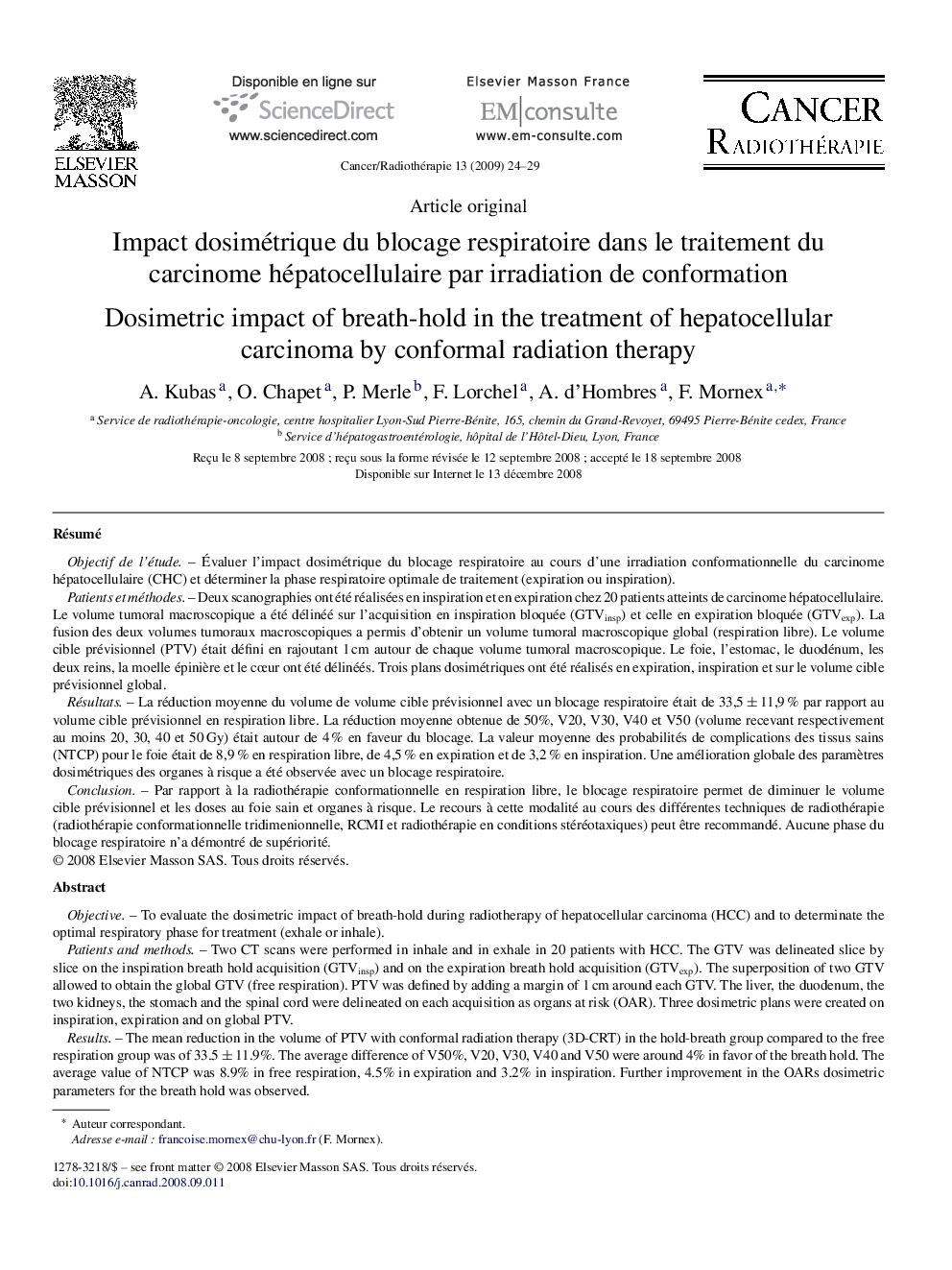| کد مقاله | کد نشریه | سال انتشار | مقاله انگلیسی | نسخه تمام متن |
|---|---|---|---|---|
| 2119164 | 1085276 | 2009 | 6 صفحه PDF | دانلود رایگان |

RésuméObjectif de l’étudeÉvaluer l’impact dosimétrique du blocage respiratoire au cours d’une irradiation conformationnelle du carcinome hépatocellulaire (CHC) et déterminer la phase respiratoire optimale de traitement (expiration ou inspiration).Patients et méthodesDeux scanographies ont été réalisées en inspiration et en expiration chez 20 patients atteints de carcinome hépatocellulaire. Le volume tumoral macroscopique a été délinéé sur l’acquisition en inspiration bloquée (GTVinsp) et celle en expiration bloquée (GTVexp). La fusion des deux volumes tumoraux macroscopiques a permis d’obtenir un volume tumoral macroscopique global (respiration libre). Le volume cible prévisionnel (PTV) était défini en rajoutant 1 cm autour de chaque volume tumoral macroscopique. Le foie, l’estomac, le duodénum, les deux reins, la moelle épinière et le cœur ont été délinéés. Trois plans dosimétriques ont été réalisés en expiration, inspiration et sur le volume cible prévisionnel global.RésultatsLa réduction moyenne du volume de volume cible prévisionnel avec un blocage respiratoire était de 33,5 ± 11,9 % par rapport au volume cible prévisionnel en respiration libre. La réduction moyenne obtenue de 50%, V20, V30, V40 et V50 (volume recevant respectivement au moins 20, 30, 40 et 50 Gy) était autour de 4 % en faveur du blocage. La valeur moyenne des probabilités de complications des tissus sains (NTCP) pour le foie était de 8,9 % en respiration libre, de 4,5 % en expiration et de 3,2 % en inspiration. Une amélioration globale des paramètres dosimétriques des organes à risque a été observée avec un blocage respiratoire.ConclusionPar rapport à la radiothérapie conformationnelle en respiration libre, le blocage respiratoire permet de diminuer le volume cible prévisionnel et les doses au foie sain et organes à risque. Le recours à cette modalité au cours des différentes techniques de radiothérapie (radiothérapie conformationnelle tridimenionnelle, RCMI et radiothérapie en conditions stéréotaxiques) peut être recommandé. Aucune phase du blocage respiratoire n’a démontré de supériorité.
ObjectiveTo evaluate the dosimetric impact of breath-hold during radiotherapy of hepatocellular carcinoma (HCC) and to determinate the optimal respiratory phase for treatment (exhale or inhale).Patients and methodsTwo CT scans were performed in inhale and in exhale in 20 patients with HCC. The GTV was delineated slice by slice on the inspiration breath hold acquisition (GTVinsp) and on the expiration breath hold acquisition (GTVexp). The superposition of two GTV allowed to obtain the global GTV (free respiration). PTV was defined by adding a margin of 1 cm around each GTV. The liver, the duodenum, the two kidneys, the stomach and the spinal cord were delineated on each acquisition as organs at risk (OAR). Three dosimetric plans were created on inspiration, expiration and on global PTV.ResultsThe mean reduction in the volume of PTV with conformal radiation therapy (3D-CRT) in the hold-breath group compared to the free respiration group was of 33.5 ± 11.9%. The average difference of V50%, V20, V30, V40 and V50 were around 4% in favor of the breath hold. The average value of NTCP was 8.9% in free respiration, 4.5% in expiration and 3.2% in inspiration. Further improvement in the OARs dosimetric parameters for the breath hold was observed.ConclusionCompared to the conformal radiotherapy with free respiration, the breath-hold allows reducing the volume of the PTV and the doses to the healthy liver and organs at risk. The use of this modality during different radiotherapy techniques (3D-CRT, IMRT and stereotactic) may be recommended. No difference in dosimetric value has been observed between the breath hold in expiratory and inspiratory phases.
Journal: Cancer/Radiothérapie - Volume 13, Issue 1, January 2009, Pages 24–29